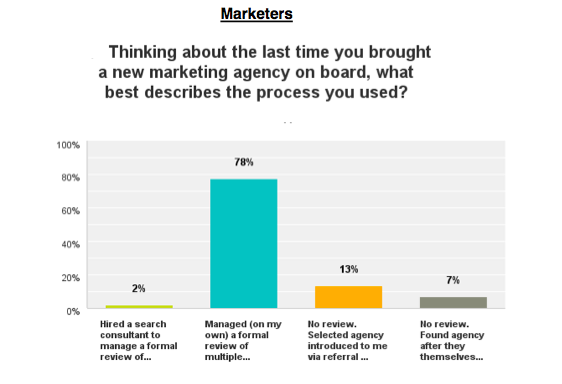

Too many agency new business programs are run according to an Excel spreadsheet.
Even worse, many agencies rely on one person (sometimes the founder or CEO) with an impressive Rolodex.
It’s an unorganized and unsustainable way to grow an agency. And it’s why a recent survey by RSW/US found that in 80% of agencies, the tenure of a new business director is less than two years. Compare that with the frequently discussed average tenure of a CMO, which is currently almost four years.
With every new biz director that leaves or is fired, the agency has to start over with no idea where prospects were in the sales process.
“The most important asset of an agency is the knowledge it gains through new business, so it’s really important that that’s not held by an individual,” said David Brown, executive vice president at customer engagement agency Meredith Xcelerated Marketing (MXM). “Agencies all copy each other, so ultimately we have 1% point of difference, but if we can use that knowledge faster, then you have a chance to grow faster than your competitors.”
This endless cycle of new business leaders who have to start from scratch harms both the agency’s staff and reputation.
And this can be avoided with one tool — a customer relationship management (CRM) tool.
With a CRM tool, agencies can create a unified sales process and collect data that will produce clear, actionable insights they can use to improve their sales process, forecast more accurately, and understand their most profitable clients.
“The nature of new business has changed in the last two or three years because clients are experimenting a lot more at the moment,” Brown said. “They’re not really committing to agencies, so there’s a lot more development work going on. I think the role of new business is actually becoming more important.”
This increase in important means it is time for your agency to upgrade its new business sales and prospecting program. Here are five reasons why:
1. Identify the Right Prospects
Maybe you are blogging, creating offers (ebooks, templates, etc.), or even used paid advertising to drive traffic and convert visitor into leads.
But how do you know which potential clients are the right prospects so you can better target your marketing outreach? You’ve been to enough “meet and greets” to know there are some clients who just don’t understand the true cost or time required to design and develop a website or create a public relations strategy.
By pairing forms on your site with an intuitive CRM that shows historical data, you can sort through prospects by qualifiers that help you understand the prospects most likely to buy. Your team can go into a pitch or proposal process knowing that the prospect is the right fit.
Brown’s team qualifies leads based on 10 questions. If the client answers seven of the 10 questions to the agency’s standards, MXM identifies it as an account it has the “right to win.” This is the type of account the agency can pursue with confidence.
2. Recognize Your Best Customers
With a CRM, you can view the full timeline of a lead’s journey to becoming a client — from the initial phone call or visit to your website to upselling the client on a new service to the client providing a referral.
Collecting and analyzing this data is key to understanding what types of clients you create long-lasting relationships with and the group of clients that are gone after one project. The first group includes the clients you want to spend time more time with, ensuring they are happy with the work and have seen results from the relationship. The second group will be one you want to monitor to understand if the costs to acquire and produce work are worth it. Remember: You can fire a client.
3. Understand the Buying Journey
Do you know the stages in the your agency’s sales process? Can you forecast your sales for next quarter or even next month?
With a CRM, you are able to define the various stages in your client’s buying process, which will help your team understand which prospects are likely to buy, who is unlikely to become a client, and the reasons why a brand chose you or another firm. You can also be proactive about responding to potential clients’ concerns and hesitations.
You probably already gather this information. Now you just need to organize and use it to inform your future new business process. And it’s worth it for any sales professional tasked with new business. RSW/US’s survey found that 66% of agencies felt that their new business professional was unsuccessful because of his or her lack of methodology.
Brown mentioned a story about Shelly Lazarus, the former CEO of Ogilvy. She said that Ogilvy would do new business by night and service clients during the day.
“That’s wrong,” Brown said. “It should be mainstream. The new business leaders who are succeeding are the ones who combine both salesmanship with a strategic sensibility. That’s a very rare profile.”
4. Increase Sales Productivity
How much time does your new business team spend uploading email correspondence, recording the details of conversations, attaching files, or updating contact information?
This type of manual data entry is a waste of your team’s time and resources.
With a CRM that logs emails and phone conversations, provides insights on the company or person you are working with, and connects the dots between on and offline interactions, your sales team can do what you hired them to do — land new and profitable clients.
5. Automate Client Nurturing Campaigns
A CRM can also be used to inform lead nurturing and content marketing campaigns for current and past clients and prospects.
Imagine if your new business professionals could create a campaign that sends a series of emails to prospects who expressed an interest in reconsidering their marketing plan in two months? The same idea could be applied to the CMO of brands whose revenues dipped in their previous earnings report. You can educate and entice these potential clients, and determine their interest based on criteria such as open rate and click rate.
Our buying behaviors have changed. While referrals and networking might produce new clients, it isn’t something you can depend on. It’s inefficient, and it produces an unstable flow of new business to your agency — a problem you can solve by investing in and understanding your agency’s data.

![How to Create a Profitable Annual Business Plan [+Free Template]](http://53.fs1.hubspotusercontent-na1.net/hubfs/53/00-Blog_Thinkstock_Images/new-biz-planning.png)








